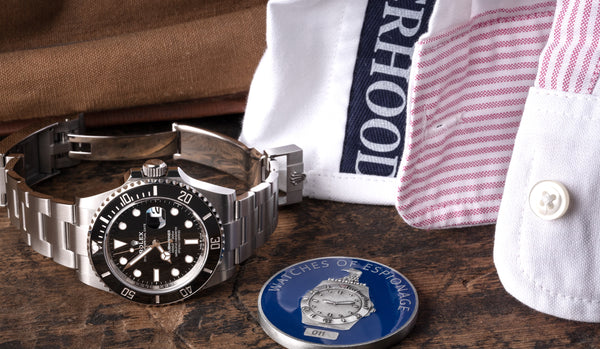The "Escape and Evasion" Rolex
The final requirement to be certified as a CIA Case Officer (C/O) is to pass the certification course at a classified government training center commonly referred to as “the Farm.” Students learn the tradecraft to clandestinely recruit and handle assets. The entire learning process is a surreal experience, and the atmosphere at “the Farm” is somewhere between a college campus with a constant stream of students riding by on cruiser bikes (IYKYK), a covert paramilitary base with state-of-the-art tactical facilities, and Hogwarts, a place where you learn the dark arts they don’t teach in regular school.
Like most government training programs, the curriculum is divided between classroom lecture and discussion sessions combined with significant role-playing and practical applications. The third, and largely unofficial, pillar of the training is informal mentoring from the instructors and Independent Contractors, all of whom are former Case Officers with significant real world experience. True to the stereotype, much of these conversations happen over beers at the facility’s notorious watering hole after long days of training.

(Photo Credit: James Rupley)
One night after a Surveillance Detection evolution, our small group was sitting in that dimly-lit bar, nursing our drinks as we listened to grizzled old Africa Division C/O regale stories of his decades “on the continent” during the Cold War. It was late, the evening was wrapping up, and the bartender rang the bell for last call. Suddenly the instructor stood up and tapped a Rolex GMT-Master on his wrist, “I will leave you with one point: always wear a Rolex. A fellow Case Officer traded his for the last seat on a plane out of (REDACTED) during the (REDACTED) Civil War in the 70s, and that watch saved his life. A story for another time.”
The moment quickly passed, like many others during that six month period that I have long forgotten. I never heard the full story, I still don’t know if it was true or just typical bravado from a crusty old C/O who never let the truth get in the way of a good story.

(Rolex Coke 16710 on W.O.E. DNC Strap, Photo Credit: James Rupley)
Rolex as an Escape and Evasion Tool:
Visit any internet watch forum or social media page on military watches and you are bound to see someone claim they know someone who was an “operator” who wore a Rolex to barter their way out of a bad situation. But have watches ever really been used for this purpose? Or are these only tall tales told over beers?
I know many people (myself included) who wore a luxury timepiece while operational at CIA and in the Special Operations community. We have documented many of them on Watches of Espionage in the past. While the main purpose of the watch was not for Escape and Evasion (E&E), that was always an option and a contingency plan if needed.

(Photo Credit: James Rupley)
The concept is simple: Should you find yourself in need of immediate help, the watch can be utilized as a form of currency that can be traded for a few hours of shelter in a basement, a ride to the nearest international border, or a seat on the next plane out of a war-torn nation. A Rolex is easier to carry and less likely to be misplaced than ounces of gold or stacks of hundred dollar bills. The brand has a perceived inherent value and is immediately recognizable throughout the world. CIA finance officers will not reimburse a personal watch if used for this purpose, but ultimately it was a financial risk I was willing to take in my overseas operations.
Bottom Line Up Front (BLUF), we have never heard a confirmed story of a CIA officer using a timepiece in this manner. But that’s not to say it’s a total fallacy, there are indeed some historical examples of timepieces being used, or at least intended, for this very purpose. Let’s explore:
WWII Life Barter Kit:

(Photo Credit: Naval History and Heritage Command)
Starting in World War II, the US Navy issued pilots Escape and Evasion (E&E) Barter Kits. This one, likely from the late 1950s or 1960s, was a sealed black rubber kit containing two gold rings, a gold chain and pendant, and of course a Milus Snow Star watch on a cloth strap. The watch boasted a 21 jewel movement with a date function. The general idea was that if an aircraft was downed in enemy (or even friendly) territory, the items could be traded with locals to aid in an escape. They were mostly issued in the Pacific theaters of WWII, Vietnam and the Korean War, although it is unclear whether they were actually leveraged for their intended purpose.
Special Forces and the Vietnam War:

Navy SEALS wearing Tudor Submariners in Vietnam (Photo Credit: Unknown)
There is significant documentation that Special Forces, Navy SEALs, and CIA officers wore Rolex, Tudors and other timepieces throughout the conflict in Southeast Asia. While some of these watches were issued for their primary purpose- to tell time - they could also be purchased tax-free at the Post Exchange (PX) for a “months salary” - anywhere from $150-$250, which is a couple of thousand in today’s dollars. While former MACV-SOG legend John Stryker Meyer, or “Tilt” to those that know him, told W.O.E. that many of his comrades purchased Rolex watches that were to be used as a potential bartering tool during escape and evasion, we have not yet seen documented examples of watches actually used for this purpose.
U-2 Incident-Cold War:

USAF pilot Gary Powers holds a model of the U-2, a high-altitude reconnaissance aircraft.
On May 1st, 1960, USAF pilot Francis Gary Powers was shot down while flying a reconnaissance mission in Soviet airspace, causing the infamous 1960 U-2 incident that had significant diplomatic implications during the height of the Cold War. Powers carried an E&E kit containing maps, a compass, gold coins, Soviet Rubles, and four gold watches. Of course, Powers was immediately apprehended and was unable to utilize the watches for their intended purpose. He spent 1 year, 9 months, and 10 days as a prisoner of the USSR.

Gary Power’s E&E Kit on display in Moscow (Photo Credit: Unknown)
Behind Enemy Lines- Bosnia:

O’Grady hugs his wife after rescue, a "Pepsi" Rolex GMT-Master visible on his wrist. (Photo Credit: Getty Images)
In June 1995, Air Force Captain Scott O’Grady’s F-16 was shot down by a Serb-controlled 2K12 Kub mobile surface-to-air missile while flying a routine combat air patrol. In one of the few modern documented examples of E&E in hostile territory, O’Grady spent six days evading capture before his rescue by US Marines. Like many pilots, O’Grady wore a “Pepsi” Rolex GMT-Master on his wrist, a gift from his father. However, O’Grady did not view the watch as a tool for escape, but as a motivation to push him to return home. O’Grady would later recall, “I knew what would happen if I was captured. The Rolex would be gone in a wink . . . a nice little war souvenir for somebody. I was determined that would never happen. Nobody was going to capture me.”
Breitling for a Toyota- Ukraine:

Andrew Smeaton, Breitling not pictured, (Photo Credit: toggle magazine)
During the chaotic days following Russia’s 2022 invasion of Ukraine, Andrew Smeaton, the CISO of DataRobot, reportedly traveled to Ukraine to assist with the evacuation of one of his employees. When he arrived in Poland, he found it was difficult to rent a car to drive into Ukraine. So, he reportedly traded his Breitling for a “15-year-old Toyota that was low on oil and needed duct tape to keep the hood in place.” The rest is history, Smeaton was able to drive the car into the warzone and make contact with his employee for a safe return. Smeaton would later recall, "It's never like the movies, right? There's no James Bond. There's no Aston Martin."

(Photo Credit: James Rupley)
The Verdict:
So what's the verdict? Has a timepiece been used to barter for one's escape from a warzone or bad situation? Unfortunately, I’ve lost contact with that crusty old Case Officer, and despite my years serving “on the continent,” I was never able to confirm the story as fact or myth. Like many great espionage stories, we must leave this question unanswered–for now.
As we discussed in a previous Dispatch, "Timepiece Crime And Traveling With Watches," things have changed and today the risk of traveling with a Rolex may outweigh the potential benefits. At a certain point the watch may be more likely to get you in a bad situation than out of one. It is a liability, not an asset.
Our exploration of “Watches of Espionage” is still in its infancy, and we would not be surprised to learn of a story where a Rolex or other high-end timepiece was used by a Case Officer or SpecOps operator to get out of a jam. If you have, drop us a line–you won’t have to trade your watch for the opportunity to tell the story.
Read Next: Criminal Rolex Gangs And Traveling With Watches, Part I
This article has been reviewed by the CIA's Prepublication Classification Review Board to prevent the disclosure of classified information.








13 comments
I think you may have come up with a valid reason for an operative to wear a really good counterfeit Rolex… :- )
I bet Putin rocks one of Gary Powers’ watches from time to time.
@ PAT – WOE has mentioned previously that G-shocks, specifically the big mud-master types, are dead giveaways for American servicemen. A non-descript older Rolex could easily fly under the radar – especially on a nato or leather strap.
A few journalists in the 60’s (my father being one of them) wore Rolexes for similar reasons, whether to bribe their way out of a sticky situation or buy their way onto the last plane leaving Saigon. Like the stories in the article, I’ve not heard of journalist actually using the watch for that purpose. I work in the same field and though I don’t wear his Rolex on assignment, I still follow the advice of wearing a watch that’s nice enough for a bribe, but cheap enough that you’re willing to use it for a bribe.
“Its a liability, not an asset.” This is also my judgement based on experience from traveling around the world. You’re better off wearing a nondescript plain old Seiko or a Casio g-shock which doesn’t attract the wrong kind of attention.